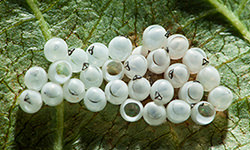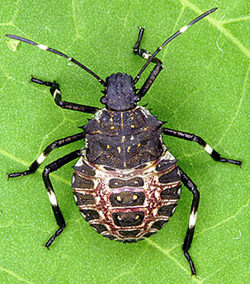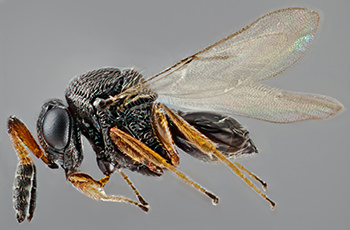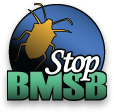IPM for the Brown Marmorated Stink Bug: Part 2
 |
| Empty egg cases, H. halys (Courtesy Wil Hershberger) |
 |
| Nymph, H. halys (Courtesy EPA) |
Box A. Biology of BMSB
Life stages are eggs, 5 nymphal instars, and adults. Females lay clusters of barrel shaped, white to light green eggs (1.6 mm) every 5–7 days on the underside of leaves. About 9–16 batches of eggs are laid over a 2–3 month period. Batch size averages about 28, and lifetime egg production ranges from 100–500, averaging about 240 (Lee et al. 2013; Medal et al. 2012; 2013; Hoebeke and Carter 2003).
Adult H. halys are about the size of a dime, approximately 17 mm (5/8 in) long. They have typical stink bug “shield” shape, and are almost as wide as they are long. Adults are marbled brown in color, antennae have white bands, and edges of the abdomen have alternating light and dark markings. Nymphs range from 2.5 to 12 mm (1/10 to 1/2 in), according to age of instar. Later instars have marbled brown bodies with red, black and white abdomen markings and white banded legs and antennae. Only adults have functional wings, so nymphs must walk everywhere they go (Ingels and Varela 2014; Jacobs 2014).
Eggs hatch in 4–5 days, and each nymphal instar lasts about a week, except the 5th instar continues for two weeks. Development from egg to adult is about 1.5 to 2 months. Adults live an average of about one year, and overwintering spring adults usually die after egg laying is completed (Lee et al. 2013).
Adults emerge in the spring, spend about two weeks feeding, then mate and start laying eggs at about the end of May. Eggs hatch in June and July, and fall adults have developed by August. Fall adults usually go into reproductive diapause and start looking for overwintering sites in September. These fall adults overwinter, emerge next spring, lay eggs and die in the summer. Life cycle of H. halys is determined by day length and temperature. In warmer areas, there can be two or more breeding generations each year (Lee et al. 2013; Medal et al. 2012; 2013).
Monitoring
Monitoring can be done with pheromone traps or light traps, visual estimation, beat samples and sweep net samples (Leskey et al. 2012b; Lee et al. 2013; Nielsen et al. 2013; Nielsen and Hamilton 2009b).
Blacklight traps are useful to monitor for adult activity and mobility (see Resources). H. halys is more active at night, and males and females are equally attracted to light. White light attracts more H. halys than blue light. Blacklight populations can provide timing for taking beat samples (Nielsen et al. 2013; Leskey et al. 2012c).
Black pyramid traps baited with pheromones are useful monitoring tools, and they are commercially available (see AgBio Resources). [See photo on the front page.] Larger traps give better results than small ones, and placement on the ground is more effective than in a tree canopy (Leskey et al. 2012c).
Pyramids are about 1.22 m (4 ft) high, and on top is a 1.9 liter (2 qt) jar containing a lure (see Box B) and a killing strip of pesticide. In apples, traps were spaced 5 m (16.4 ft) from orchard edges, 20–25 m (65.6–82 ft) apart. The black pyramid shape is attractive probably because bugs mistake it for the trunk of a tree. Initial tests were done with MDT aggregation lures (see Box B). Attraction increased with the amount of MDT in the lures (Leskey et al. 2012c).
Beat samples are used for trees or woody shrubs. Limbs are tapped three times with a rubber bat at height of 1.5 to 3 m (5 to 9.8 ft). Startled insects drop into a canvas beat sheet 71 cm by 71 cm (28 in by 28 in) (see BioQuip Resources). One early season adult per 10 trees could result in economic damage. If first instar nymphs are found in beat samples, the tree should be visually inspected for egg masses (Nielsen and Hamilton 2009b).
Sweep nets are better than beat samples for monitoring soybeans (see Resources BioQuip). But large pyramid traps baited with aggregation pheromones can detect bugs earlier in the season than sweep net samples. Bugs move into soybean during critical bean development times. The full pod (R4) stage is most vulnerable, and 4 bugs per 0.3 m-row (4 per 1.0 ft-row) could cause economic damage (Nielsen et al. 2011; Owens et al. 2013).
Physical Barriers
Row covers could be effective in a garden situation. Sticky barriers around tree trunks could stop nymphs and many adults. Bags have been used to protect fruit, but this would be impractical for large orchards (Lee et al. 2013; Jacobs 2013). Netting has been used to protect houses (see below) (Watanabe et al. 1994).
Traps
Successful traps include light traps and pyramid traps. Light traps outside are mostly used for monitoring. Properly placed light traps inside may help with reduction of overwintering populations (see Sterling Resources). Pyramid traps are mostly used for monitoring, but the pheromone lures can be used to cause H. halys aggregations that can be destroyed by biopesticides (Leskey et al. 2012c).
Trap crops may be successful. Early maturing soybeans have been used as a trap crop to protect late season varieties (Lee et al. 2013). Fall planted triticale, crimson clover and vetch, and spring planted sunflower and buckwheat have been recommended as trap crops in the Southeast. Bugs can be removed with vacuums or sweep nets (Mizell 2014).
Boxes packed with straw, paper, or straw mats have been used as overwintering traps. Slit traps made of layered wood have also been used in this way (see below) (Watanabe et al. 1994; Lee et al. 2013).
Repellants
H. halys is repelled by essential oils. Clove, lemongrass, spearmint, and ylang-ylang oils are nearly 100% repellent. Wintergreen, geranium, and rosemary are 60–85% repellent. The aggregation pheromone of the spined soldier bug, Podisus maculiventris, is also repellent. The pheromone is a mixture of alpha-terpineol and (E)-2-hexenal (Aldrich et al. 2007; Zhang et al. 2013).
Though essential oils are repellent, they volatilize quickly and do not provide ongoing protection. Effectiveness might be improved with encapsulated, slow release formulations. Repellants might also be used in combination with H. halys aggregation pheromones in a “push pull” strategy to augment mass trapping or increase effectiveness of attract and kill formulations.
Biological Control
 |
| Trissolcus halyomorphae. (Courtesy S. Valley, Oreg. Dept. Ag.) |
Biological control is an important component of brown marmorated stink bug IPM. Since they are not mobile, eggs are the most vulnerable stage of H. halys. Though eggs hatch within 4–5 days, females lay clusters about every 5–7 days, providing a continuous supply of eggs vulnerable to parasitoids and predators for at least 10–12 weeks (Medal et al. 2013).
Our native parasitoids have not yet adapted to H. halys, and parasitism rates are less than 5% (Aldrich et al. 2007). Classical biological control may provide a solution. The H. halys U.S. introduction likely came from Beijing (Xu et al. 2014). Trissolcus halyomorphae is an effective H. halys egg parasitoid from that area. Parasitism rates of 20–70%, averaging 50%, are common. The parasitoid overwinters as an adult, and its populations are synchronized with H. halys. The parasitoid produces 10 generations a year. Female to male ratios are about 5:1, and one female parasitizes all the eggs in a typical 28-egg BMSB cluster before moving on. T. halyomorphae is identical with T. mitsukurii, which is found in Japan (Yang et al. 2009).
Stink bugs produce stinky defensive secretions to deter predators. But birds eat nymphs and adults anyway (Ingels and Varela 2014). General predators such as lacewings, ladybugs, and pirate bugs, Orius sp. feed on H. halys eggs. Predation of H. halys eggs by spiders and bigeyed bugs, Geocoris sp. in Maryland soybeans can approach 50% (Leskey et al. 2012a). Many of the same predators attack our native stink bugs, following them from crop to crop (Tillman 2010; 2011).
Tachinid flies such as Euclytia flava are attracted by MDT aggregation pheromones. So pheromone monitoring can increase biocontrol when both tachinids and pests are drawn to the same areas (Aldrich et al. 2007).
Biopesticides
Conventional management of BMSB is multiple applications of pesticides. However, of 37 pesticides tested, residues of about one-third killed less than 50% of the bugs. Pyrethroids tend to knock them down, but many bugs recover within 7 days (Leskey et al. 2012e).
Biopesticides may be just as effective as more toxic or environmentally destructive materials. As well as mortality, they can have valuable sublethal effects. Neem (azadirachtin) formulations act as antifeedants and may decrease fecundity. Pyrethrins are repellent and can be lethal (Lee et al. 2013). The combination of neem and pyrethrins (Azera™) can be used in organic agriculture (Jacobs 2014).
Chitin synthesis inhibitors such as novaluron and diflubenzuron are not effective against eggs or adults, but will kill nymphal stages. Sprays applied during June and July will target developing nymphs (Kamminga et al. 2012).
Some microbial biopesticides show promise (Quarles 2013). Chromobacterium sp. (Grandevo®) (see Marrone Resources) is more effective than the pyrethroid esfenvalerate and many other conventional pesticides (Leskey et al. 2012d). Laboratory tests of Chromobacterium showed 100% mortality against the southern green stink bug, Nezara viridula (Martin et al. 2007).
The Japanese fungus, Ophiocordyceps nutans, specifically attacks stink bugs (Sasaki et al. 2012). Fungi such as Beauveria bassiana or Metarhizium anisopliae are effective against H. halys (see Resources). Lab tests showed several isolates of B. bassiana, including a commercial formulation (BotaniGard™) gave 100% mortality to H. halys. Isolates of M. anisopliae produced about 85% mortality. MET52™ is a commercial formulation of M. anisopliae (see Resources) (Gouli et al. 2012).
Pesticide Reductions
In soybeans H. halys accumulates on field edges. Spraying only the periphery reduces pesticide use by 85%, while retaining effectiveness. Most of the damage done in apples and sweet corn is also done in outer rows (Leskey et al. 2012ac).
Spray reductions may result from a knowledge of H. halys behavior. Adults fly up to the trunk of a tree, then walk up the trunk into the canopy. Since nymphs have no wings, they also walk into the canopy. Banding tree trunks with pesticides or sticky barriers could reduce the amount of pesticides applied. Pyramid traps baited with aggregation pheromones may also be used to lure the pest to discreet locations, reducing applied pesticides (Leskey et al. 2012ac).
Leskey et al. (2012c) baited trees with aggregation pheromones to reduce pesticide applications. Nine trees in a border row were baited with pheromones, then pesticides were used to destroy the bugs.
At temperatures of 21 °C (70 °F) or less, Li et al. (2007) achieved an 88% reduction in pesticides applied to trees by beating trees with sticks, causing BMSB to drop to the ground. Pesticides were then applied to bugs on the soil.
 |
Page 2 of 4 |  |
